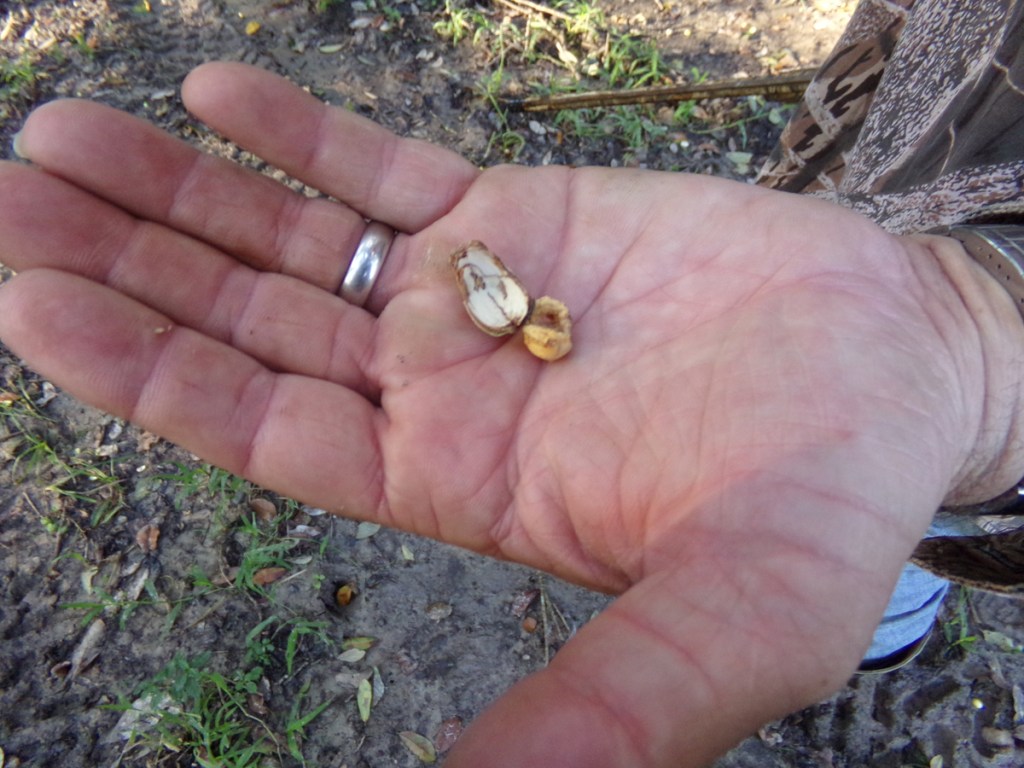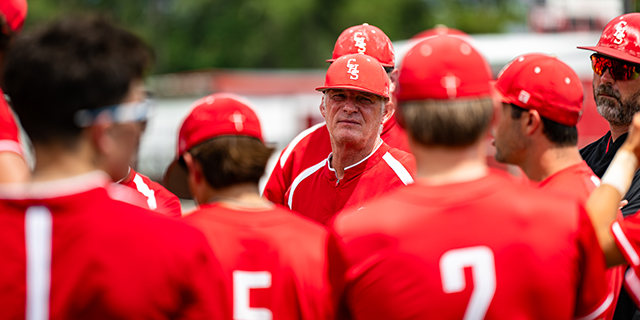There’s more than tip of the cap for Prados’ squirrel hunting tips
Published 6:45 am Sunday, October 17, 2021

- Edmund Burke shows the cuttings left by hungry squirrels under a white oak tree that he hunted at the end of a morning trip with Wilbert Prados. Burke pointed out if the cuttings are ringed in brown they’re probably old.
Wilbert Prados, an 80-year-old outdoorsman, had two pairs of old socks on top of his shotgun shells and another two pairs of old socks atop his compass on a morning squirrel hunt Oct. 7.
Prados, who lives with his wife near Willow Wood Park, also wore a short-billed cap and watched intently for tell-tale cuttings and/or spent shotgun shell casings on the ground. Those and his other tips can enhance a hunter’s opportunity to bag squirrels.
Trending
The veteran, successful squirrel hunter is going at it still. After a so-so (for him) opening day Oct. 2 in the Atchafalaya Basin, Prados eagerly shared what he has learned over seven decades of squirrel hunting.
Going out second time this season
His second squirrel hunt of the season was with a friend less than half his age, Edmund Burke of New Iberia. Burke, 36, invited the outdoorsman he met while running hoop nets several years ago to go squirrel hunting on his family property near Lake Dauterive.
What made the trip special is Prados’ roots are on that property in Iberia Parish just past Choupique Canal. His grandfather, Honore Prados Sr., and father, Honore Prados Jr., raised families on their property dating way back.
Prados, a retired commercial fisherman who mostly ran hoop nets 40 years in Lake Dauterive-Fausse Pointe, returned to the land he was born and raised on to hunt squirrels. It looks nothing like it did when he was born in January 1941, or, even, when he left the area three decades ago.
He pointed to a group of old oak trees as the two hunters drove home after the squirrel hunt, noting the home he grew up in was near there, a structure long since gone.
Trending
“Those trees right there?” Burke asked as he drove his pickup truck.
Prados nodded his head and said yes. He hadn’t been on the property in 20 years and recognized very little of the land he played and hunted on as a boy.
“Man, how things change,” Prados said.
The Burkes purchased 350 acres three years ago from the Delhomme family, Burke said. The late Dick Delhomme and his wife, Rebecca C. Delhomme, hand-planted thousands of oak, cypress, persimmon and other trees on the property soon after Delhomme purchased it.
Delhommes planted trees
Delhomme made specific plans to plant species together in different areas based on topography. Those trees stand tall today.
“When he bought it, my dad promised Mrs. Delhomme he wouldn’t remove the trees” but would trim them, Burke said.
Some of those trees were inhabited by “cat” (gray) squirrels five days after the 2021 small game hunting season opened in Louisiana. Finding those trees was a challenge for Prados, who shot at two squirrels with his 16-guage shotgun using No. 6 shot on a 2 ½ -hour hunt, but less of one for Burke, who carried four squirrels to his pickup truck after picking them off with his Browning A-5 12-gauge shotgun using No. 8 shot.
Prados didn’t see cuttings that give away a squirrel’s position. Fresh cuttings have brightly colored edges, a sign squirrels have been feeding in an area on walnuts, beechnuts, hickory nuts, butternuts and other hard mast.
Prados hunted opening day with family and friends, paired with a grand-nephew, Trevor Prados, a young teen who bagged his first squirrel, plus seven more, near Grand Bayou in the Atchafalaya Basin. Prados was proud of his continued role as a mentor for squirrel hunters.
“Boy, he had a smile on his face,” he said.
The former banker (he worked four years at New Iberia National Bank, three years at Iberia Savings & Loan before realizing catfish he caught paid more) was hopeful other tidbits from his squirrel hunting career benefit others.
Prados’ squirrel hunting tips
# Hunt between swamps and ridges, hardwoods and tupelos. Target cypress trees whenever possible.
# Learn to tell tree species by the trunk. For example, the foliage on ash and pecans look the same but each can be ID’d by the shape of the trunk — an ash looks like an upside down ice cream cone while a pecan’s trunk is the same size all the way up.
# Walk or stay concealed in the shade/shadows. Avoid sunlight as much as possible in the woods because eagle-eyed squirrels can spot you easier.
# Wait two minutes after shooting and knocking down a squirrel and never walk straight to it. If other squirrels are around, there’s a chance they’ll make a move.
# Pick a wounded squirrel up by the tail and immediately swing it consistently against something. Wait and the squirrel might curl up, sink its teeth into a thumb and not let go, like one did when he was a boy. He learned the hard way.
# If a squirrel keeps running to the other side of a tree, throw a stick on that side, or run/walk in circles around the tree to confuse it.
What about the old socks? They muffle or eliminate any clicking sounds that alert squirrels, Prados said.
The short-beaked cap he wears enables him to scan treetops easier than a long-billed cap.
Spent shotgun shells on the ground are self-explanatory.
The Oct. 7 squirrel hunt began with enough light to walk the woods. Burke, a former diesel mechanic offshore who is studying for a master’s degree in business at UL-Lafayette, shot the first squirrel at 6:55 about a quarter-mile away from Prados. He shot three times 10 minutes later, knocked three down and found two.
Teaming up against bushy-tails
The two friends met up about an hour later, about the time a moving branch high above the ground caught the attention of Prados. He couldn’t get a good bead on the squirrel, though, so the two teamed up.
“He’s going to screw up,” Burke said about the four-legged critter.
The squirrel won, however, and skedaddled after Burke shot twice.
“No squirrels to talk about. All the amount of woods we’ve covered and we haven’t seen a lot of cuttings, none to speak of,” Prados said.
As they approached a clearing near a recently flooded pond, a squirrel tantalized them. Both shot more than once and believed they saw the squirrel fall. They searched in vain for the body.
“You actually got to shoot your gun,” Burke said.
“He didn’t look too dead” on the fall, Prados said.
Burke agreed and said, “When he came down, he looked kind of lively. Oh well. You can’t get them all.
“This (area near clearing) was my best spot when we first bought the property.”
He killed six around there opening day.
As Burke hunted squirrels with Prados, he couldn’t help but look ahead to getting the Slainte (Irish for cheers), his father’s 39-foot long Contender, ready for another red snapper fishing trip. The Burkes and friends are enjoying the extended recreational red snapper season – seven days a week with a 4-fish creel limit — announced by the state Department of Wildlife and Fisheries on Sept. 22.
Burke, a member of the Spanish Lake Commission, savors his friendship with Prados. After meeting up with him several times on the lake, they started fishing together, he said.
“I’ve never met a better guy than Will. He has a heart of gold. I love Mr. Will. He’s great. I have zero tips on squirrel hunting,” he said, respectfully.
Prados has the tips and the will to hunt at any age.





